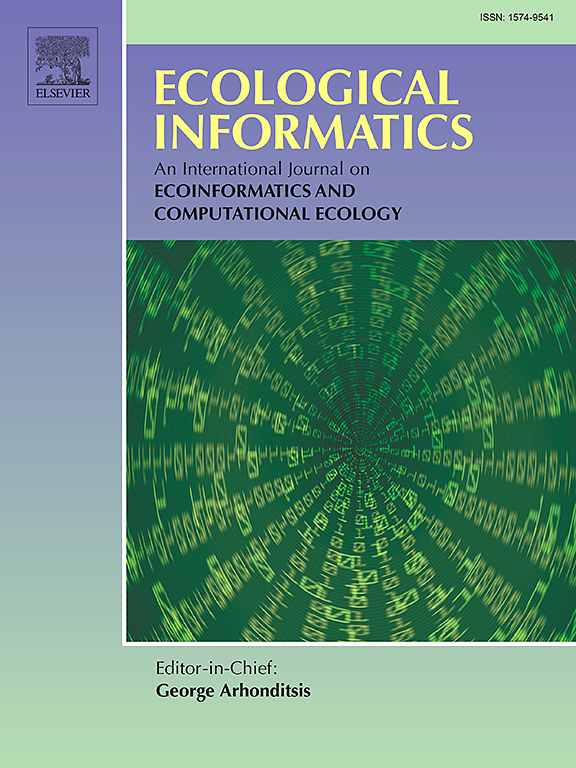Enhanced Yolov8 network with Extended Kalman Filter for wildlife detection and tracking in complex environments
IF 5.8
2区 环境科学与生态学
Q1 ECOLOGY
引用次数: 0
Abstract
Amid a growing global focus on ecological conservation and biodiversity monitoring, the efficient identification and tracking of wildlife are essential for environmental research, wildlife protection, and habitat management. Nevertheless, intricate landscapes, varied animal sizes, and obstructions obstruct wildlife detection and tracking. This study introduces the wilDT-YOLOv8n model, specifically engineered for the effective identification and tracking of animals. Initially, the Stable Diffusion model augments the dataset, establishing a basis for training data. Subsequently, enhancements to the Yolov8n model are implemented through the incorporation of the deformable convolutional network DCNv3 and the utilization of the C2f_DCNV3 layer to augment feature extraction efficacy, while addressing detection challenges associated with small targets and intricate backgrounds by integrating the EMGA attention mechanism and the ASPFC feature fusion module. Enhancing the Extended Kalman Filter algorithm guarantees reliable and precise tracking. The research findings reveal that the wilDT-YOLOv8n model attained an average detection accuracy (mAP50) of 88.54 % on the custom dataset, reflecting a 4.57 % enhancement over the original YOLOv8n model; the refined Extended Kalman Filter realizes a Multi-Object Tracking Accuracy (MOTA) of 40.35 %, representing a 3.923 % advancement over the original Kalman Filter. The results indicate the feasibility of accurately detecting and monitoring wildlife in intricate environments, offering significant insights for ecological research and biodiversity conservation, and aiding in the protection of endangered species.
使用扩展卡尔曼滤波器的增强型 Yolov8 网络,用于在复杂环境中探测和跟踪野生动物
随着全球对生态保护和生物多样性监测的日益关注,有效识别和追踪野生动物对于环境研究、野生动物保护和栖息地管理至关重要。然而,错综复杂的地形、大小不一的动物以及各种障碍物阻碍了野生动物的探测和追踪。本研究引入了 wilDT-YOLOv8n 模型,该模型专为有效识别和追踪动物而设计。最初,稳定扩散模型扩充了数据集,为训练数据奠定了基础。随后,通过纳入可变形卷积网络 DCNv3 和利用 C2f_DCNV3 层来增强特征提取功效,同时通过整合 EMGA 注意机制和 ASPFC 特征融合模块来解决与小型目标和复杂背景相关的检测难题,从而对 Yolov8n 模型进行了增强。增强扩展卡尔曼滤波算法可确保可靠和精确的跟踪。研究结果表明,在定制数据集上,wilDT-YOLOv8n 模型的平均检测精度(mAP50)达到 88.54%,比原始 YOLOv8n 模型提高了 4.57%;改进后的扩展卡尔曼滤波器的多目标跟踪精度(MOTA)达到 40.35%,比原始卡尔曼滤波器提高了 3.923%。这些结果表明了在复杂环境中准确探测和监测野生动物的可行性,为生态学研究和生物多样性保护提供了重要启示,并有助于保护濒危物种。
本文章由计算机程序翻译,如有差异,请以英文原文为准。
求助全文
约1分钟内获得全文
求助全文
来源期刊

Ecological Informatics
环境科学-生态学
CiteScore
8.30
自引率
11.80%
发文量
346
审稿时长
46 days
期刊介绍:
The journal Ecological Informatics is devoted to the publication of high quality, peer-reviewed articles on all aspects of computational ecology, data science and biogeography. The scope of the journal takes into account the data-intensive nature of ecology, the growing capacity of information technology to access, harness and leverage complex data as well as the critical need for informing sustainable management in view of global environmental and climate change.
The nature of the journal is interdisciplinary at the crossover between ecology and informatics. It focuses on novel concepts and techniques for image- and genome-based monitoring and interpretation, sensor- and multimedia-based data acquisition, internet-based data archiving and sharing, data assimilation, modelling and prediction of ecological data.
 求助内容:
求助内容: 应助结果提醒方式:
应助结果提醒方式:


